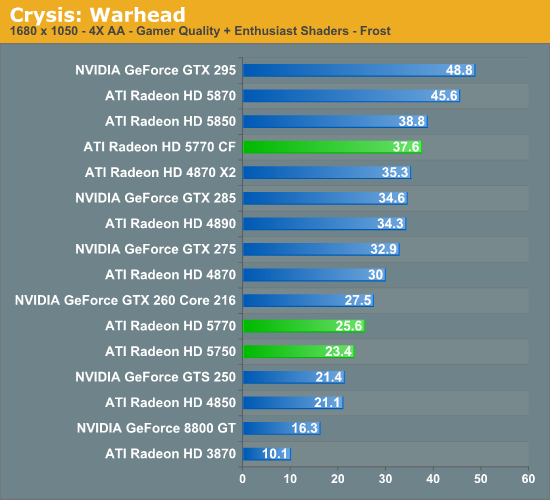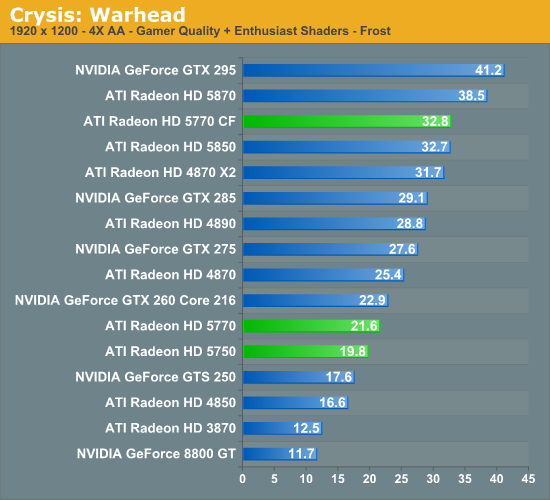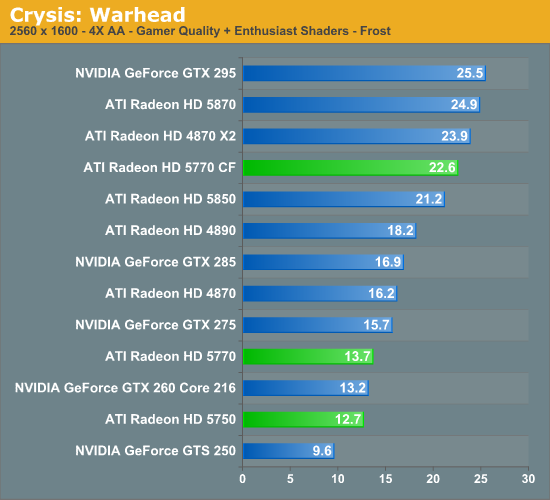AMD’s Radeon HD 5770 & 5750: DirectX 11 for the Mainstream Crowd
by Ryan Smith on October 13, 2009 12:00 AM EST- Posted in
- GPUs
Crysis: Warhead
Kicking things off, we’ll start with Crysis: Warhead. Warhead is still the single most demanding game in our arsenal, with cards continuing to struggle to put out a playable frame rate with everything turned up.



Update: As a few of you pointed out, there was something a bit off with our Crysis results; we had a Radeon 4850 beating the 5770. As it turns out we wrote down the maximum framerate for the 4850 instead of the average framerate. None of the other results were affected, and this has been corrected. Sorry, folks.
There are a few different situations we’re going to be interested in. The first is the matchup between the 5770, the 4870, and the GTX 260. The second is the matchup between the 5750, the 4850, and the GTS 250. The third is the 5770 as compared to the 5800 series, in order to see what another $100 or $200 is buying you in the Evergreen family.
Unfortunate for the 5770, this is not a game that treats it well. In spite of the clock speed advantage over the 4870, and the architectural advantages (extra caches and what-not), it underperforms the 4870 by about 15% here. AMD had once told us that they believed that they weren’t memory bandwidth constrained on the 4870/4890, but when that’s the only significant difference between the 5770 and the 4870 that would explain the performance difference (certainly Juniper wouldn’t be slower than RV770), we are beginning to doubt that. Meanwhile the GTX 260 outscores the 5770 here too.
Looking at the 5770 compared to the 5850, $100 buys you roughly 50% more performance.
The 5750 fares much better here. It beats the 4850 by 10%-20%, and beats the GTS 250 by a similar margin.










117 Comments
View All Comments
hsoverma - Tuesday, October 13, 2009 - link
I bought a 3870 for about 210.00 a year and a half ago. This card has double the performance, a lot more features, and is starting at 160.00. I figure by christmas, it will be down around 120.00. I run a small frag-box, so the lower heat and lower power makes sense for me over a 4870, and if I ever wanted more power, I could run two of these in crossfire and have all that I need. I am putting this card on my wish-list. Thanks again for a great review.7Enigma - Tuesday, October 13, 2009 - link
Great article except for the flaw of not a single Memory OC data point. If as the data shows the 5770 is performing poorly due to inadequate memory bandwidth (seemingly the ONLY issue hampering performance when comparing specs between it and the 4870), it makes sense that a simple OC could shed some light on this issue. Please update the article with some numbers as this card is mainstream enough that I would imagine overclockers *could* see this as a gem in disguise.Ryan Smith - Tuesday, October 13, 2009 - link
Once things calm down, we're going to do a 5800 series overclocking article. It's something that takes a while to put together, and there are major product launches every week right up through the end of this month.7Enigma - Wednesday, October 14, 2009 - link
Can you give us a hint then whether this memory has the potential to overclock well enough to where the bottleneck is overcome? I doubt it can completely remedy the situation but if the memory overclock was enough to make up for the significantly narrower bus in most cases, I think this card would have a better reception.Etern205 - Tuesday, October 13, 2009 - link
Just a stupid question...ATi's Eyefinity requires a display port monitor to work properly (saw on youtube video), and what it does is makes the image share across the screen.
My question is can you use the ATi card and use all monitors independently without the eyefinity feature?
squeezee - Tuesday, October 13, 2009 - link
Yes, you can run the displays independantly just as with any other card. However the 3rd monitor always needs to be Displayport. (or use an ACTIVE displayport adapter)EJ257 - Tuesday, October 13, 2009 - link
I'm sure there is a perfectly good explanation for this that I'm missing. You say there is 1 SIMD disabled in the 5750 vs the 5770. Looking at the chart on the first page there is a difference of 80 stream processors and 4 texture units between the 5750 & 5770 so this would indicate 4 SIMDs are disabled.EJ257 - Tuesday, October 13, 2009 - link
Wait, never mind. I see each SIMD consists of 4 texture units and 20 SP (Stream Processors) and each SP contains 4 Stream Cores. I guess in the chart when you say Stream Processors you really mean Stream Cores right?yacoub - Tuesday, October 13, 2009 - link
Ryan - THANK YOU for including the 8800GT in the graphs: That is the card I (and many other potential buyers) will be upgrading from, moving to a DX11 card.It's too bad this new card (5770) can't quite catch the GTX260 C216, as that is its main NVidia competitor in performance and price. It uses just as much Load wattage as a 260, but seems to offer around 80-90% of the performance. Perhaps if they hadn't cut the bandwidth to 128-bit, it would have squashed the GTX-260. But ATI has a habit of under-bussing their cards and it continues to negatively impact high resolution performance, no matter what certain reviewers might claim about the bus-width not hurting performance. Time and again, testing shows potential for improvement from a wider bus.
Blah. ATI, you always come so close to getting me to purchase but there's always something to hold me back. Perhaps if/when this card drops to $139 (without rebates). But by then NVidia might have their answer out and the GTX-260 would also drop in price or be replaced with a DX11 part, and then the 5770 again loses appeal.
MadMan007 - Tuesday, October 13, 2009 - link
I think you'll pass out if you try to hold your breath waiting for a lower midrange NV DX11 answer to these cards.